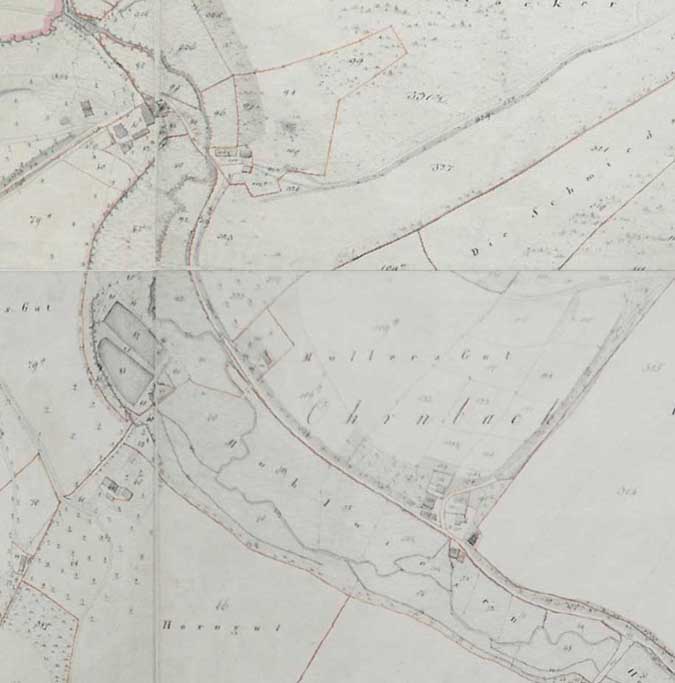|
OHRNBACH,
BAVARIA, GERMANY
|
 Ohrnbach
Topographic Map
Ohrnbach
Topographic Map
 1848 Survey
of Ohrnbach
1848 Survey
of Ohrnbach
|
John Anthony
Fertig
and his family lived in the village of Ohrnbach,
formerly
known as Ohrenbach,
in the
state of
Bavaria,
Germany
(Bayern,
Deutschland).
Ohrnbach
is located in the
quiet and peaceful Ohrn Brook valley of the Odenwald mountains of
Germany1.
The village is located approximately six miles west of Miltenberg in
the district of Miltenberg, province of
Unterfranken, in the northwestern
corner of the state of Bavaria. Ohrnbach is incorporated into the town of Weilbach1,
which is located approximately four miles to the southeast.
The word Ohrnbach
is translated as "Ear Brook" in the English language.
Several designations have been given to the village:
"Der zerstreut
liegende Ort", "Der verschwundene Ort" and "Der arme Ort", which translate
as
"The absent-minded lying place", "The disappeared or lost place" and "The
poor or pauper place"2. The village of Ohrnbach was
spelled various ways throughout history: Arnbach, Arenbach, Aranbach,
Ohrenbach, Ornbach, Orenbach and Ohrnbach2.
The village is located adjacent to
the Ohrn Creek at an approximate elevation of 755 feet. The adjacent
rugged mountains rise up to approximately 1,570 feet for a total height of 815 feet above the valley. The mountains are comprised of woodlands mixed
with coniferous and deciduous trees. The topographic map of the
region indicates an area named Fertigsgrund, located approximately 0.7
miles to
the northeast of Ohrnbach. This area, translated as "Fertig's
Ground", was likely property once owned by a relative of John Anthony Fertig.
Ohrnbach was
comprised of approximately 15 residents, 4 houses and a hotel, as of the
year 20033.
The town held nearly 300 residents in the past2, however, today
most of the old village has been converted to fields and woodlands3.
The village
has over 700 years of historical documentation1.
The following is a summary of the significant historical events of Ohrnbach:
Year
Event
1266 Village first mentioned under the name
Arenbach1.
1468
Counts von Wertheim in possession of the fishery rights of the
valley2.
1535-1648 Village completely devastated and deserted due to
the Swedish and French War2.
Village residents were killed or driven from their homes2.
1656
Resettlement of Ohrnbach2,3.
1660
50 cows, 28 pigs and 300 sheep recorded2.
1720
Village chapel recorded3.
1724 Teachers named and lessons performed
in farmer's houses1.
1776 Catholic chapel constructed1.
1838-40
Many inhabitants of Ohrnbach sold their land and relocated elsewhere2.
1857 Schoolhouse located near the chapel1.
1873 Schoolhouse located in a farmer's
house today called "prince-house"1.
1880 Ohrnbach community dissolved1. The
Prince of Leiningen
purchased a portion of the village1. Many families left the village
and moved two miles southeast to Weckbach3. Ohrnbach was incorporated into Weckbach1.
1895 Chapel torn down1. The door
and lintel were moved to the Weckbach church1. The stones from the
chapel
were also
used to expand the church in Weckbach3.
1947 Temporary school located in the house
of forest until 19501.
1959 The
Gasthof Ohrnbachtal
(Ohrnbach
Valley Hotel) opened in the center of the village by Karl and
Ernestine Schäfer4.
1965
Electricity first introduced in the village4.
1997 Memorial stone at the former place of the chapel erected
by the home village association1.
The stone is located 0.6 miles from Ohrnbach3.
2003
Most of the old village covered by forest and field2.
The
following is a historical record of the inhabitants of Ohrnbach2:
Year Inhabitants
1496
52
1668 37
1700 72
1710 81
1720 83
1730 71
1740 64
1750 75
1760 96
1770 89
1780 91
1790 102
1800 72
1820 167
1826 196
1834 284
1840 284
1862 180
1897 22
1950 30
2003 15
John Anthony
Fertig and his family attended the Catholic chapel in Ohrnbach, which
was part of the Catholic parish of Weilbach. Several of John
Anthony's children were baptized in the
Weilbach church called
“St. Johannes”,
after the apostle John5. The church has been documented
historically back to around 14505.
The church has a classical style pulpit, which was placed in 1789 and has
two gothic wood figures, which originate from the fifteenth century5.
John Anthony
Fertig took his family and fled from Ohrnbach, Bavaria in 1837, during the
reign of
Bayerisch King
Ludwig I6. In 1825, Ludwig I succeeded the throne of his father,
King Maximilian I6. King Ludwig I was
in power until the Revolution of 1848, which caused his abdication
in favor of his son,
King Maximilian II6. This royal Wittelsbach
family had reigned
the
Bayerisch region since they came to power in 11406.
It was
recorded that the
Prince of Leiningen purchased a significant portion of land in the
surrounding region of Ohrnbach between 1838 to 18402. It
is possible that John Anthony Fertig sold his land to the prince and used
the proceeds to fund the relocation of his family to America.
REFERENCES:
1. History
of Ohrnbach.
http://www.weilbach.de/html/static/html/ueber_weilbach/geschichte_ohrnbach.htm
Retrieved information on October 22, 2003
2.
Weilbach Und Seine Ortsteile, Geschichte Unserer Heimat, Band I, II and
III.
Weilbach And Its Local Parts, History Of Our Homeland, Volumes I, II and
III
3.
History
of Ohrnbach.
E-mail correspondence with N.S., Ohrnbach/Weckbach area resident on
October 24, 2003 and October 25, 2003
4.
History of the Gasthof Ohrnbachtal
(Ohrnbach
Valley Hotel).
http://www.gasthof-ohrnbachtal.de/gesch.html
Retrieved information on October 22, 2003
5. History of Weilbach and Weckbach Churches.
http://www.weilbach.de/html/static/html/ueber_weilbach/kirchen_1.htm
http://www.weilbach.de/html/static/html/ueber_weilbach/kirchen_2.htm
Retrieved information on October 22, 2003
6. History of
Bayerisch
Kings.
http://members.surfeu.fi/thaapanen/s823.html
http://enigma.cs.ucla.edu/games/falkenstein/hall.htm
http://www.ulib.iupui.edu/kade/springer/Ch1/figure_1.html
Retrieved information on July 25, 2002
|
|
 Ohrnbach
Topographic Map
Ohrnbach
Topographic Map